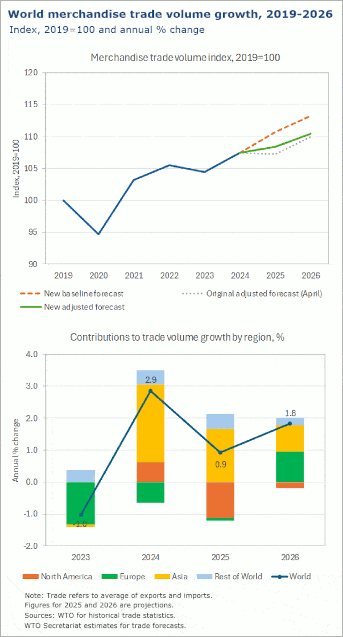
A +0.9% increase in trade is expected in 2025
compared to last year, an increase that has
higher than the -0.2% contraction expected in April, but
down from the previous estimate of +2.7% increase
the tariff increases introduced by the US Presidency of
Donald Trump. The new forecast on the evolution of trade is
was formulated today by the World Trade Organization (WTO) and is
was defined mainly on the basis of advances
relating to imports into the United States and in the first quarter of the
have seen a surge in view of tariff increases
widely expected.
 If the "reciprocal" duties announced and then introduced and
therefore negotiated by the US administration constitute a
watershed in world trade, however, the WTO warned
their effect will be felt in the second quarter of 2025
and, above all, in 2026 when the expected growth in volume
of trading will be +1.8% compared to the previous estimate
by +2.5%.
If the "reciprocal" duties announced and then introduced and
therefore negotiated by the US administration constitute a
watershed in world trade, however, the WTO warned
their effect will be felt in the second quarter of 2025
and, above all, in 2026 when the expected growth in volume
of trading will be +1.8% compared to the previous estimate
by +2.5%.
The World Trade Organization has announced that the latest estimates
indicate a decline in both exports and
North American imports, with declines expected respectively of
-4.2% and -8.3%, trade flows that for the whole of 2026 are
currently expected to mark percentage changes year on year
equal to +0.7% and -2.4% respectively. For Europe, in 2025 it is
A -0.9% drop in exports and an increase of +0.4% is expected
of imports, percentage changes that are expected in 2026
both will be positive and equal to +3.6% and +2.7%.
With regard to Asia, 2025 is expected to end with
Exports and imports up by +4.9% and +3.3% and are expected in 2026
increases of +1.3% and +2.8%. Trade is also on the rise
of the world, with +1.2% and +6.8% respectively of the
exports and imports in 2025 and with changes in
+1.3% and +2.7% in 2026.
Commenting on the latest forecasts for 2025, the director
General of the WTO, Ngozi Okonjo-Iweala, noted that "the
Global trade has shown resilience in the face of shocks
including recent tariff increases. Imports
and the improvement in macroeconomic conditions have
made a modest improvement to the outlook for 2025.
However, the overall impact of the recent tariff measures has
is still demonstrating. The shadow of tariff uncertainty continues
to weigh heavily on business confidence,
investments and supply chains. Uncertainty remains one of the most important
disruptive forces in the global trade environment.
However, it is important that
A wider cycle of retaliation has been avoided so far
"eye for an eye", which could be very harmful
for global trade".